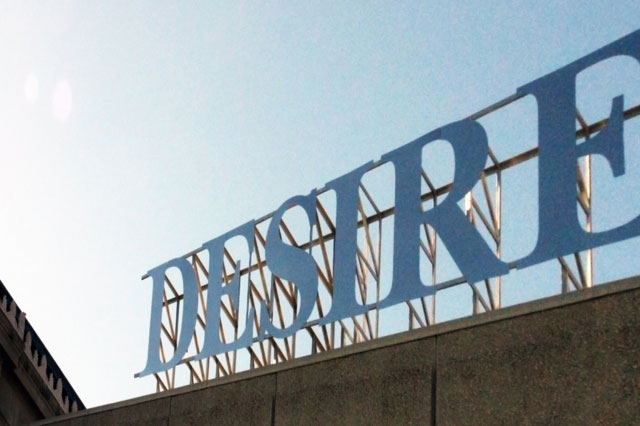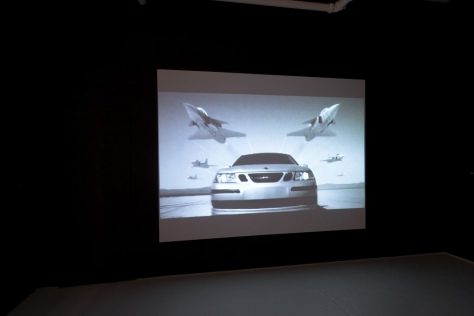
Monica Bonvicini, Desire (2006), Installation view, New Orleans Museum of Art, Photograph by: John d’Addario, Prospect 1, New Orleans
When people say “The party’s over” they literally mean it. There weren’t as many visitors in Miami this year, and the ones who came were stressed out. I always like writing about the fairs, but I can’t say I enjoyed myself as much as I have in past years; pointing out needlessly lavish art is far more fun than discussing why a fair is conservative and boring.
I’d probably be a lot more cranky right now if I hadn’t just spent a few days in New Orleans visiting Prospect 1., curator Dan Cameron’s Biennial brainchild, and the literal antidote to art fair malaise. Organized in part to help rebuild the city after the devastating effects of hurricane Katrina, the biennial takes place in seemingly countless locations across town. Three days ago I probably would have complained about having to drive through traffic, but in contrast to Miami, a very unfriendly car city and one often noted for it’s robust and expensive T&A culture, exploring the city of New Orleans offers stunning architecture, rich cultural history, great cheap food, amazing music, and right now a large amount of phenomenal art.
Probably the most exciting aspect of Prospect 1. lays in the artist’s response to Katrina and the city itself, a focus that could have easily backfired. After all, asking anyone to respond to something they aren’t already actively investigating frequently results in assignment art; well intentioned but ultimately uninspired, even rinky dink projects. But almost across the board, artists passionately responded to the city. It helped that Prospect 1 organizers went out of their way to help artists working on site specific installations choose their own locations rather than simply giving them a predetermined space. I’m not sure if this is standard procedure for biennial curating — unlike other critics who are very tired of the forum, New Orleans is the first I’ve attended — but surely these kinds of decisions keep the event from become route and conventional.

Nari Ward, Diamond Gym (2008), Installation View, Battle Ground Baptist Church, Lower 9th Ward. Photograph by: John d’Addario, Prospect 1, New Orleans
Given the size of the venue, and the amount of time I had to spend in New Orleans (basically a day and half) my post unfortunately only reflects the works I had time to see. Peter Schjeldahl remarks in the New York that the biennial takes three days to view in its entirety, a rather optimistic number in my view. I did however manage to see a number of the main locations and talked about works, in particular, Nari Ward’s Diamond Gym. Placed inside the Battle Ground Baptist Church, its roof lined with the watermarks left from Katrina, Ward’s muscular diamond shaped armature made from old workout machines mimics the structure of the building. Small wavy water-like lines cover the mirrors that bracket the piece, while small fliers stapled on the outside of the walls evoke the papered surfaces once visually defining the neighborhood after the hurricane. Ward draws inspiration not only from New Orleans but from the Rev. Al Sharpton’s office for the National Action Network, a repurposed gym, located just outside the artist’s studio in Harlem for which the piece is named after. An assemblage of Martin Luther King Jr. and other speeches fills the space, the gym mirrors powerfully reflecting both the weight of the disaster and the growing strength of the people.

Skylar Fein, Remember the UpStairs Lounge (2008), Installation view, Contemporary Arts Center, Photograph by: John d’Addario, Prospect 1, New Orleans
Not all of the art responds so specifically to Katrina. Local artist Skylar Fein’s installation in the Remember the Upstairs Lounge for example, tells the story through text, mounted photographs and engraved wood, of the Upstairs Lounge, a popular gay men’s club in the French Quarter set a fire by whom many believed to be a disgruntled customer in 1973. 32 died, 15 were badly injured, meanwhile, in a small peep show booth in the main room, CBS attributes their incomplete reports to the bizarre idea that the bodies were hard to identify because homosexuals frequently used fake identities. The installation’s contemporary soundtrack is one of a few clues throughout the moving memorial presents a mix of fictional and real memorabilia ranging from gritty crime scene photos, recreated doors, and beefcake posters.

Josephine Meckseper, 0% Down, 2008, Video, Duration 6 minutes. Photo: Elizabeth Dee Gallery, Prospect 1, New Orleans
Arguably, Josephine Meckseper’s 0% Down has nothing to do with New Orleans, but I don’t see any reason for every piece in the biennial should the city so specifically. The video collages footage from various car commercials to the tune the industrial-noise song “Total War” by Boyd Rice, mercilessly isolating the portions of car commercials designed to make vehicles look like war machinery.”If it had a script the only line would be: “Illustrate the obvious ties between the car industry and wars fought over oil.” Meckseper told Liam Gillick in Interview magazine last month. Probably the most obvious connection she describes is illustrated when a truck must drive through two oppositely swinging hammer pendulums resembling oil rigs. Aggressive and forceful, the American portrait reconstructs the raw desire within the marketing of these cars, set in stark contrast to Monica Bonvicini’s more wistful Desire, set atop the New Orleans Museum of Art.
Had Meckseper’s piece been made a couple years ago, my first viewing would very likely have been at Art Basel Miami, an environment I can’t imagine would benefit the work much. Of course, it likely be on display shortly at one of these fairs anyway, but Prospect 1, at least presents a welcome, albeit short reprieve from that kind of exhaustive commercial environment. And I for one felt like while I was there, I couldn’t possibly get enough of it.
A New Orleans photo essay with commentary will follow, though perhaps not until Monday as I am traveling.


{ 2 comments }
That Meckseper piece is really interesting. I saw it on a trip to New York this summer at Elizabeth Dee, but it was contextualized by a wild installation then. Her script defines the content, but there’s a conversation about style there too. I’m not sure if it’s more stylish to like beautiful cars or to make art against the oil industry, but I was glad to see Meckseper note the fashion of both.
This seems like a really interesting show, people have been mentioning it more than I would have expected. Looking forward to your photo essay.
That Meckseper piece is really interesting. I saw it on a trip to New York this summer at Elizabeth Dee, but it was contextualized by a wild installation then. Her script defines the content, but there’s a conversation about style there too. I’m not sure if it’s more stylish to like beautiful cars or to make art against the oil industry, but I was glad to see Meckseper note the fashion of both.
This seems like a really interesting show, people have been mentioning it more than I would have expected. Looking forward to your photo essay.
Comments on this entry are closed.